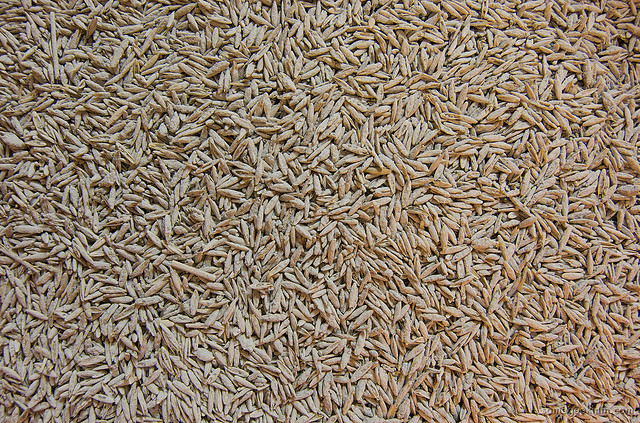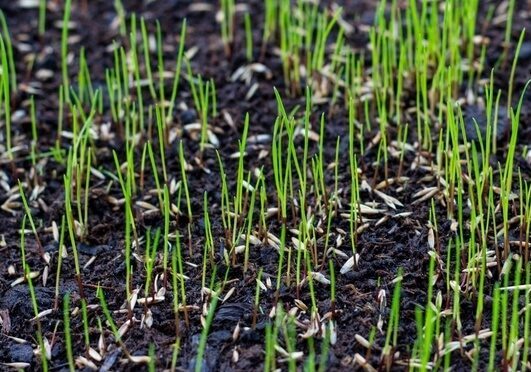Seed germination is complex and influenced by a number of factors. Let’s take a look at what’s involved and where things go wrong
Water: Water is one of the basic pillars of life and essential to many critical functions. Once water is in short demand critical functions shut down. It is crucial for seed germination because it activates enzymes that break down stored food reserves in the seed. It also helps to soften the seed coat and allows the developing seed embryo to expand and emerge from the seed coating. Remember that dry seeds are inactive until the time they receive some moisture. Once this happens it is essential that the seed remains moist until the new plant is able to find its own water through its developed root mass.
Temperature: Warmth is key to seed germination. Think about it, if seeds germinated in freezing conditions, then they wouldn’t be able to get roots into the soil and find moisture. Therefore, soil temperatures need to be high enough to trigger seed germination and remain high enough during the early stages of development to enable the establishment of the new plant.
 Many modern grass seeds will germinate as low as 5 degrees. Soil temperature changes less quickly than air temperature. It holds on to heat for longer in the autumn and can often still be cold when early spring days feel warm. Understanding soil temperature is key to when seeds can be sown and how quickly the new plant develops.
Many modern grass seeds will germinate as low as 5 degrees. Soil temperature changes less quickly than air temperature. It holds on to heat for longer in the autumn and can often still be cold when early spring days feel warm. Understanding soil temperature is key to when seeds can be sown and how quickly the new plant develops.
Oxygen: Seeds require oxygen for respiration, which provides energy for germination. Adequate oxygen levels in the soil or growing medium are essential for seed germination.
Light: Some seeds require light for germination, others do not. Grass seeds are typically distributed onto the surface of soil but will germinate well even with a slight covering of soil which inhibits some light. A lack of direct sunlight following germination can have a serious impact on the development of the new plant as this is needed for photosynthesis, and low light levels will mean the plant is less able to create energy through photosynthesis.
Seed Quality: Seeds deteriorate over time. Stored correctly some seeds can remain viable for hundreds of years. Ensuring seeds are fresh and stored in the right conditions increases germination success.
pH Level: Soil acidity can impact germination success. However, grass seeds are tolerant of quite a wide range of soil pH. If the soil is found to be particularly acidic then we can select grass varieties better suited to these conditions.
 Nutrients: The seed itself contains all that is needed to ensure germination, and seeds contain stored nutrients that provide initial nourishment to the new plant until it can establish its own root system and start photosynthesizing. However, it is essential that new plants are provided with the right nutrition to support their establishment following germination
Nutrients: The seed itself contains all that is needed to ensure germination, and seeds contain stored nutrients that provide initial nourishment to the new plant until it can establish its own root system and start photosynthesizing. However, it is essential that new plants are provided with the right nutrition to support their establishment following germination
Microorganisms: Certain beneficial microorganisms in the soil, such as mycorrhizal fungi, can enhance seed germination and establishment by improving nutrient uptake and root development. Typically, we use seeds that are pre-coated with this beneficial fungi to aid rapid development.
Time: Germination is a time-dependent process. Establishment takes time too. Patience is key. Germination of grass plants, in the right conditions, can take between 5 and 30 days. Often you need to get down on your knees and up close to the soil to see the tiny new grass leaf just emerging from the seed.
Don’t assume seed has not or will not germinate until you have given it the right conditions, adequate time, and you have properly inspected to see any evidence of new growth.
What is the difference between germination and establishment?
Germination
Germination usually occurs shortly after you’ve sown the grass seeds into the prepared soil. This is the initial stage of seed growth where the embryo within the seed begins to grow and develop into a seedling. It’s the stage where you’ll see tiny seedlings emerging from the soil.
It typically starts when a seed absorbs water, produces enzymes to break down the seed coating, and swells. As detailed above, it requires the right environmental conditions, including proper temperature, moisture, and oxygen levels.
During germination, the seedling sends out its first root (the radicle) and shoot (the plumule) as it emerges from the soil. The seed leaf (cotyledon) seeks out light to begin photosynthesis, whereby the plant can use energy from the sun, and carbon dioxide, to create sugars to provide energy for the plant to grow and oxygen which is released into the atmosphere by the plant.
Establishment
Establishment refers to the subsequent stage where the seedling grows into a mature plant with a well-developed root system and foliage. Establishment takes longer and involves the seedlings growing, spreading, and developing into mature grass plants that cover the soil surface effectively.
This stage involves the continued growth and development of the seedling into a healthy, self-sustaining plant. Factors that contribute to establishment include ongoing moisture, appropriate nutrients, proper sunlight, and protection from pests, disease, and adverse conditions such as waterlogging.
It’s during the establishment phase that the lawn begins to take on a denser and more uniform appearance. Seedlings in the establishment phase are vulnerable and require careful attention to ensure they grow into robust, mature plants. This is where many seeded lawns fail and often that failure is moisture related. People forget to water after the seed has become wet and that seed then dries out and dies as the emerging plant is unable to access its own moisture as its roots are not yet developed.
Lawn seeding success
Overall, germination is the initial sprouting of grass seedlings from the soil, while establishment involves nurturing and caring for these seedlings until they mature into a healthy, fully developed lawn. Successful establishment of a lawn requires ongoing care and maintenance, such as regular watering, fertilisation, mowing, and protection from pests, disease, and foot traffic. Once the lawn has fully established, it becomes more resilient and better able to withstand any issues that nature throws at it. But remember what I stated at the start of this article – water is essential for life and for the essential functionality of your grass plants.

What are the main reasons that lawn seed fails to establish fully?
Lawn seed can fail to establish fully for various reasons, many of which relate to unfavourable growing conditions or inadequate care.
Insufficient Watering: Inconsistent or inadequate watering can prevent seeds from germinating and seedlings from establishing. Newly sown grass seeds need consistent moisture to grow. Drought conditions can be especially detrimental.
Poor Soil Preparation: Seeds need soil contact to germinate and to establish. Grass seed will germinate laying on any damp surface, but unless the root reaches the soil, that new grass plant will die before it can find its own nutrition and moisture to sustain its establishment.
Improper Seed Depth: Planting seeds too deep or too shallow can prevent proper germination. Grass seed in nature is distributed by the wind. It does not need deep burial to germinate but some seed convert does help establishment and prevent seeds being taken by birds.
Competition from Weeds or other Grasses: Other plants can outcompete grass seedlings for resources like sunlight, water, and nutrients. It’s better to create space for the new seeds to reach the soil and establish. Ideally scarify or aerate before over-seeding a lawn.
Inadequate Fertilisation: Grass seedlings require adequate nutrients to grow and establish. Using the right type and amount of fertiliser will promote healthy growth and ensure the lawn establishes more quickly.
Poor Soil Drainage: Roots do not grow in soil, they grow in the gaps within the soil. Roots are responsible for a gaseous exchange between the plant and the atmosphere (as well as anchoring the plant and finding nutrition and moisture). If the gaps in the soil are filled with water through waterlogging then roots cannot function as they need and the plant will suffer as a result. Excessive moisture due to poor soil drainage can lead to plant death or fungal diseases.
Environmental Stress: Extreme weather conditions, such as extreme heat, cold, or drought, can stress seedlings and prevent them from establishing properly.
Pest and Disease Pressure: Insect pests and diseases can damage or kill grass seedlings. Chafer grubs eat roots. Leather jackets eat roots and emerge from soil to eat grass shoots and leaves. Proper pest and disease management is essential during establishment.
Compacted Soil: Compacted soil can limit root development and drainage, making it difficult for seedlings to establish. See soil drainage above.
Insufficient Light: Grass seedlings need adequate sunlight for photosynthesis and growth. Shady areas may have difficulty supporting grass growth.
Inappropriate Seed Selection: Choosing the wrong grass seed variety for your specific climate, soil type, or intended use can result in poor establishment.
Improper Timing: Sowing grass seed at the wrong time of year can lead to poor germination and establishment. It’s essential to sow in the right conditions which are normally dictated by the time of year.
Traffic and Compaction: Foot traffic on newly sown areas can damage delicate seedlings and compact the soil, hindering establishment.
Neglect: Neglecting proper care and maintenance during the critical establishment phase, such as mowing too early or too short, or not mowing enough to allow the grass to produce side shoots and thicken the sward or allowing the lawn to become overgrown with weeds, can impede growth.

Trust us, we are experts
We will select the right seed, ensure it is viable and correctly sown. We will provide the correct after care, ensuring weeds are controlled and plants receive nutrition. We cannot control what happens after we leave your property. If moisture levels fall, you must provide water before seeds or establishing plants die. If birds take seeds, then they will never be able to establish a new lawn. After-care, after we leave your property, is as important as preparation.

 Established 2016
Established 2016



